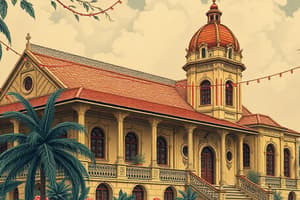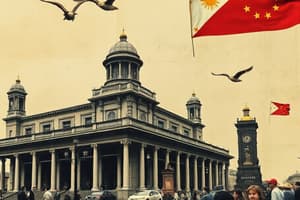Podcast
Questions and Answers
What was a notable change in governance after Woodrow Wilson's election in 1912?
What was a notable change in governance after Woodrow Wilson's election in 1912?
- Immediate independence granted to the Philippines
- Appointment of Francisco Burton Harrison as governor-general (correct)
- Removal of all American officials from local governance
- Increased American presence in the Philippine government
What did the 1916 Jones Law establish in the Philippines?
What did the 1916 Jones Law establish in the Philippines?
- Complete independence from the U.S.
- A bicameral legislature (correct)
- A military dictatorship
- An electoral college for presidential elections
What were the grievances against Leonard Wood's administration primarily about?
What were the grievances against Leonard Wood's administration primarily about?
- High taxation rates on Filipino businesses
- Authoritarian policies and local governance interference (correct)
- Economic sanctions imposed on the Philippines
- Promotion of Filipino self-governance
What was one consequence of Wood's governance on Filipino officials?
What was one consequence of Wood's governance on Filipino officials?
Which political party in the U.S. was associated with supporting long-term control over the Philippines?
Which political party in the U.S. was associated with supporting long-term control over the Philippines?
What triggered the investigations into compliance with the Jones Law under President Harding?
What triggered the investigations into compliance with the Jones Law under President Harding?
What was a key reason for the petition from Filipino leaders against Wood's policies?
What was a key reason for the petition from Filipino leaders against Wood's policies?
What impact did Wood's reinstatement of a controversial police chief have?
What impact did Wood's reinstatement of a controversial police chief have?
What period was established as the Philippine Commonwealth?
What period was established as the Philippine Commonwealth?
Who was elected president of the Philippine Commonwealth in 1935?
Who was elected president of the Philippine Commonwealth in 1935?
What major global event interrupted the Philippine Commonwealth?
What major global event interrupted the Philippine Commonwealth?
What were the Public Land Acts of 1903 and 1936 known for?
What were the Public Land Acts of 1903 and 1936 known for?
What type of literature reflects the political debates during the Japanese Occupation in the Philippines?
What type of literature reflects the political debates during the Japanese Occupation in the Philippines?
What was the impact of the Philippine-American War on the country's political landscape?
What was the impact of the Philippine-American War on the country's political landscape?
Which of the following groups experienced discrimination under the Public Land Acts?
Which of the following groups experienced discrimination under the Public Land Acts?
What term describes the collaborative relationship between the U.S. and Filipino elite during colonization?
What term describes the collaborative relationship between the U.S. and Filipino elite during colonization?
What was the main purpose of Act No. 926, passed in 1903?
What was the main purpose of Act No. 926, passed in 1903?
Which regions were explicitly excluded from the homesteading provisions of Act No. 926?
Which regions were explicitly excluded from the homesteading provisions of Act No. 926?
What misconception did Filipinos from Luzon and the Visayas hold about lands in Mindanao?
What misconception did Filipinos from Luzon and the Visayas hold about lands in Mindanao?
How did the policies of U.S. homesteading in the Philippines compare to those in North America?
How did the policies of U.S. homesteading in the Philippines compare to those in North America?
What long-term effect did the influx of settlers in Mindanao have on indigenous communities?
What long-term effect did the influx of settlers in Mindanao have on indigenous communities?
What was one of the significant social implications of the Public Land Laws?
What was one of the significant social implications of the Public Land Laws?
Which two groups were specifically mentioned as being affected by the land policies in Mindanao?
Which two groups were specifically mentioned as being affected by the land policies in Mindanao?
What issue is often attributed to the land ownership policies enacted during the colonial period?
What issue is often attributed to the land ownership policies enacted during the colonial period?
What was the primary demand of the Filipinos upon the arrival of the Americans?
What was the primary demand of the Filipinos upon the arrival of the Americans?
What tactic did the American administration use to pacify the Filipinos?
What tactic did the American administration use to pacify the Filipinos?
What was one of the significant actions taken by Governor-General Wood that angered the Filipino politicians?
What was one of the significant actions taken by Governor-General Wood that angered the Filipino politicians?
How did Wood's governance affect the principle of Filipinization?
How did Wood's governance affect the principle of Filipinization?
Which document highlights the grievances of Filipino leaders against U.S. governance?
Which document highlights the grievances of Filipino leaders against U.S. governance?
What was the expectation of Filipinos regarding Major-General Wood's governance?
What was the expectation of Filipinos regarding Major-General Wood's governance?
What was a common consequence of Governor-General Wood's arbitrary actions?
What was a common consequence of Governor-General Wood's arbitrary actions?
Which political group was more in favor of prolonged American control in the Philippines?
Which political group was more in favor of prolonged American control in the Philippines?
What role did political caricatures play during the American colonial period in the Philippines?
What role did political caricatures play during the American colonial period in the Philippines?
How did the Japanese occupation affect the production of political cartoons in the Philippines?
How did the Japanese occupation affect the production of political cartoons in the Philippines?
What common themes were emphasized in the political cartoons during the American colonial era?
What common themes were emphasized in the political cartoons during the American colonial era?
Which aspect of society did caricatures reflect during the 1930s in the Philippines?
Which aspect of society did caricatures reflect during the 1930s in the Philippines?
What was a significant characteristic of the media environment during the Japanese occupation?
What was a significant characteristic of the media environment during the Japanese occupation?
What was the portrayal of Japan in the propaganda comics during the occupation?
What was the portrayal of Japan in the propaganda comics during the occupation?
Which artist used subtle methods in their cartoons to resist Japanese occupation?
Which artist used subtle methods in their cartoons to resist Japanese occupation?
What was a key advantage of political caricatures compared to written editorials during the American colonial period?
What was a key advantage of political caricatures compared to written editorials during the American colonial period?
Flashcards are hidden until you start studying
Study Notes
U.S. Colonial Rule Dynamics
- U.S. colonial rule in the Philippines was a complex process influenced by political parties in the U.S.
- The Republican Party (McKinley, Roosevelt, Taft) favored prolonged control and favored longer term colonial rule.
- The Democrats (Wilson) pushed for earlier independence and advocated for Filipinos to gain independence.
- Wilson’s election in 1912 led to changes including the appointment of Francisco Burton Harrison, who aimed for greater Filipino participation in government.
- The 1916 Jones Law established a bicameral legislature and decreased the number of American officials in the government.
- Leonard Wood and William Cameron Forbes investigated the Philippines' compliance with the Jones Law and discovered corruption and inefficiency, leading to tension.
- Wood’s appointment in 1921 resulted in increased tension with Filipino leaders due to his authoritarian style.
- Filipino leaders resigned from political positions and protested against Wood’s policies.
Filipino Grievances Against Governor-General Wood
- The "Filipino Grievances Against Governor-General Wood" highlights the discontent of Filipino leaders with U.S. colonial governance under Leonard Wood.
- Wood’s administration was characterized by authoritarian policies, interference in local governance, and the reinstatement of a controversial police chief.
- Grievances detail accusations against Wood's administration, depicting it as oppressive and detrimental to Filipino autonomy.
- The petition calls for justice from the American public, emphasizing the leaders' commitment to self-governance and their disillusionment with U.S. promises of freedom.
Public Land Laws of the United States Colonial Government
- The "Public Land Laws of the United States Colonial Government" discusses the U.S. strategy to integrate Muslim Mindanao and its indigenous peoples throughout the colonial period.
- Act No. 926, passed in 1903, allowed Filipino citizens, U.S. citizens, and citizens of U.S. insular possessions to claim up to 16 hectares of unoccupied agricultural public land.
- The act excluded the Moro Province and some highland areas due to challenges faced by U.S. forces from local resistance in these regions, particularly from the Moro people.
- The policy of homesteading encouraged Filipinos from Luzon and the Visayas to settle in Mindanao, displacing the indigenous Moro and Lumad communities.
- By 1970, settlers controlled much of Mindanao's land, which previously belonged to indigenous people.
Cartoons and Comic Strips
- Political cartoons became significant during the American era, highlighting colonial policies and injustices in a way that written editorials could not.
- The press enjoyed a degree of freedom under American colonial rule, allowing for a critical examination of U.S. policies.
- Japanese wartime propaganda replaced American versions, portraying Japan as a benevolent liberator of the Philippines from Western imperialism.
- Some cartoonists used subtle methods to challenge their Japanese occupiers.
Studying That Suits You
Use AI to generate personalized quizzes and flashcards to suit your learning preferences.




